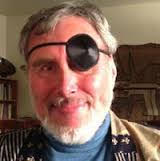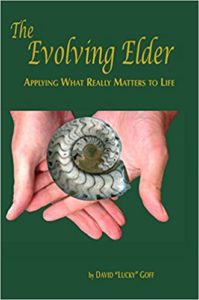
Surprising discoveries accompany aging. There is an elder awakening happening – older people are vital like they have never been before. Greying turns out to be ripening into something special!!
Providing a necessary corrective for the widespread prejudice that demise corresponds to the latter stages of life, The Evolving Elder: Applying What Really Matters to Life describes in rich and inspiring prose how evolution has created a period of life that reveals the true dignity of human existence.
Instead of dwelling on the prejudices that impede the old, this work describes elderhood in fresh terms. There are gains, which make the losses that accompany aging meaningful and essential to human well-being. It is way past time for a new look at the phenomenon of aging, an examination that reveals the ultimate dignity of human life.
The most amazing surprise of all is reserved for old age. It appears that Nature has seen to it that there is an instinctive pulling together, a ripening from within, a kind of integrative process, that renders one’s existence sensible. This is experienced at a very personal level – where we know ourselves more completely. Old people are becoming unique and free, having experiences from the inside out, knowing the truth of their own being. Here is the essence of the elder experience. The wider perspective reveals that elderhood is a stage of Life – a moment in life that clarifies the evolutionary thrust that is coming through us. — Introduction by Bing Gong
The Three Moons
What goes on four feet in the morning, two feet at noon, and three feet in the evening?
The riddle of the Sphinx is part of a mythological story, which reveals that human beings have been aware for a long time of the three stages of human life. The knowledge of what life entails, the stops the train of life is bound to make, is known. What those stages actually contain, however, is less well known. And in the case of elderhood, the last of the stages, this is particularly true.
“What goes on four feet in the morning” is childhood. What goes on “two feet at noon” is adulthood. And, what goes on “three feet in the evening” is later life. Elderhood. These three stages make up human life, they encapsulate the nature of the human journey from birth to death. These three stages reveal the arc of human fullness.
They capture how meaning unfolds and how humans ripen. And each has its own contributions to make: skip one, and the organism is stunted and malformed. Inherent in the riddle is awareness that knowledge of the wholeness of life is essential to wellbeing. This is why it is important to accurately perceive the essential nature of each stage. The goodness of life depends upon it.
I am going to briefly describe these three stages in a different way. Each of them is like a moon, exerting a gravitational influence. Each moon exerts a different force, shaping what happens, and pulling for an outcome that conveys the uniqueness, originality, and comprehensiveness of a human being. I do this because I want to highlight the role of natural dynamism in human life. I also want to discuss the third moon as equal to the others, with its own characteristics.
In addition to how life has been prolonged in the last few decades, the nature of later life has dramatically changed. The story of each stage carries familiar elements, but has been substantially altered by the perspective that emerges with a new take on what this final moon is all about. The ancients saw the last stage of being human as dignified decline. So does much of the modern world, but now it is beginning to show up as ripening, a fulfillment that is unanticipated. This leads to a new, changing story of the three (moons) ages of mankind […]
Summary [Three Moons Section]
The metaphor of the three moons represents an attempt to describe the vital natural forces at work in shaping a human life. Obviously, each stage, epitomized by its own moon, is a lot more complicated than described here. Humans are noted for the diversity of experience they embody. In an attempt to describe the natural forces at work, the gravitational effects of celestial bodies seems apt. There is something about shifting from an external perspective to an internal one that is characteristic of old age, and is difficult to perceive in our time. Doing so makes the integrative force more explicit and shows how beholden we still are to Nature.
Elderhood is the phase of life where this integrative force is strongest. All of the benefits of this stage stem from a desire, evidently spurred on by Nature, to bring all of it together, to actualize what Nature has started. The influence of Nature in this development is too important to ignore. Old people, particularly elders, are boosted in their development by this invisible, elemental force. Most of us don’t know this.
Most of us assume we are walking around orphaned by Nature. Unaccompanied. The prospect of getting old, and being subjected to the vulnerabilities (especially the physical ones) that old age brings is daunting. Add to this the bad advice about old age that is so rampant, and you have a recipe for fear and the gravest assumptions about old people.
The good news is that despite the taint of fear and prejudice, old age endures and is growing. For elders, something else a whole lot more extraordinary is happening. When it does, Life is affirmed. It becomes us; or more accurately, we become it. It is in old age, when it is possible to discover that Life has been with us throughout our journey [….]
Grandolescence (A Shifting Perspective)
The universe is changing! This means that for the majority of folks this change is among the biggest, most thorough, alterations of Life. I can’t emphasize enough that when the moon of elderhood comes over the horizon, most people are not prepared for the magnitude of change that they are to undergo. This shift is tantamount to becoming a parent and never grasping until the child comes what parenting actually entails.
Like the ancients viewing an eclipse for the first time, a lot of fear gets stirred up. It takes awhile to grasp the new reality that has just come into view. Life has other plans for us, and it is ruthlessly and impeccably carrying them out. I will describe that shift. I’ve even given it a name, grandolescence, to make it more memorable, but I know few people will believe what I am describing. Oh, they might catch the drift and remember the details of my description, but the actual experience is another matter.
This is a monumental, new change. It has its initiatory ordeals but leads to a significantly good outcome. Associating it with the grandness of Life motivated me. So did the desire to remind everybody that changing is part of the becoming that characterizes human nature. The reference to adolescence in the name intentionally refers to the changes one has to go through to be a mature human. Thus, grandolescence.
Making the adjustment to a new moon rising is hair-raising, and it has some major advantages. With the losses come the gains. The gains, however, are not obvious at first. In fact, they are obscured by the assumptions that prevail in earlier life.
The research on centenarians (people 100 or older), the fastest growing segment of the population, shows that well-being for old folks depends upon escaping the dictates of cultural assumptions. The process of escaping, at first, feels like being cut off from all which one knows. The new freedom that comes with this change of Life is often unwelcome, disorienting and threatening.
The heart of grandolescence, or the transition from adulthood to elderhood, is fraught with elements that make this shift anything but straightforward. It is like stepping through a looking glass. The nonobvious challenge (along with a significant benefit) is that the looking glass is within. Another element that makes this transition non-intuitive and difficult is that it involves a loss of control. Nature is driving this shift. It isn’t voluntary […]
Why Do Some People Grow Through Grandolescence?
Growing old, as I’ve shown, is organic. It is built into us, but we have some ability to regulate how much we grow. Not everybody is willing to submit to all that growth asks. The choice is only partly ours. This is an interesting aspect of being human. Humans grow because they have to. Growth is programmed into them, but they can influence the trajectory of that growth through their desire.
Not every species has this capacity, and what we do with it is up to us. We are an extremely adaptable species, with enormous potential. The challenge we face, however, individually and as a species, is matching our growth and development with our historical circumstances. Elders are very adept at this.
While we are living, we are subject to the influences of our environment. In the earliest stages of life others are very influential; later on, it is primarily our desire, our willingness, that determines what we make of what Life presents us with. In each case growth is a kind of dance.
As grandolescence shows, we are always partnered up with Life. Our steps determine the quality of our dance, but Life, as our partner, leads. Life leads, but how we follow is totally idiosyncratic, unique, and up to us. The dance proceeds according to a combination of moves between the two. Our responses to Life customize us, making us more or less mature. This is the privilege of being human, the contribution we humans make to creation, and it is always coupled with the ministrations of Life.
Human existence is tricky. Growing, which happens to us anyway, leads us into all kinds of tangled situations. Grandolescence is one.The lament that new parents often express, “that there is no manual, is actually true for the whole of human life. All of us are confronted with the difficult task of determining for ourselves how much we are willing to use the adaptive capacities given to each of us. This is a matter of choice. And, it is always a challenge, which separates the merely old from the wrinkled and grey beginners.
